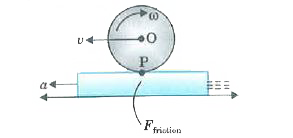What is friction ?
Step-by-Step Solution:
1. Definition of Friction:
Friction is defined as a force that opposes the relative motion between two surfaces in contact.
2. Conditions for Friction:
Friction occurs when there is relative motion or an attempt of motion between two solid surfaces that are in contact with each other.
3. Nature of Friction:
The force of friction acts in the opposite direction to the direction of the relative motion. This means that if one surface is trying to slide over another, the frictional force will act to resist that sliding motion.
4. Sliding Friction:
Friction is particularly noticeable when there is sliding between the two surfaces. This sliding friction is what we commonly experience when pushing an object across a surface.
5. Types of Friction:
There are different types of friction, including static friction (which prevents motion) and kinetic friction (which acts during motion).
6. Importance of Friction:
Friction is essential in everyday life as it allows us to walk, drive, and hold objects without slipping. It also plays a crucial role in various mechanical systems.
Friction is defined as a force that opposes the relative motion between two surfaces in contact.
Friction occurs when there is relative motion or an attempt of motion between two solid surfaces that are in contact with each other.
The force of friction acts in the opposite direction to the direction of the relative motion. This means that if one surface is trying to slide over another, the frictional force will act to resist that sliding motion.
Friction is particularly noticeable when there is sliding between the two surfaces. This sliding friction is what we commonly experience when pushing an object across a surface.
There are different types of friction, including static friction (which prevents motion) and kinetic friction (which acts during motion).
Friction is essential in everyday life as it allows us to walk, drive, and hold objects without slipping. It also plays a crucial role in various mechanical systems.
Topper's Solved these Questions
Similar Questions
Knowledge Check
In general viscous force is some what like friction as it opposes the motion and is a non-conservative force, but not exactly so, because.
Aa,bBa,dCa,cDb,dA body of mass 100g is sliding on a inclined plane with an inclination of 60∘. What is the frictional force experienced, if coeficient of friction is 1.7? (Take g=10m/s2)
A0.85NB0.95NC1.05ND1.145NA body of mass 100 g is sliding from an inclined plane of inclination 30∘. What is the frictional force experienced if μ=1.7.
A1.7×√2×1√3NB1.7×√3×12NC1.7×√3ND1.7×√2×13N
The friction of a radioactive sample which remains active aftertime t is 916. What friction remains active after t2 time?
View SolutionUsing a horizontal force 200N, we intend to move a wooden cabinet across a floor at constant velocity. What is the frictional force that will be exerted on the cabinet?
View SolutionUsing a horizontal force 200N, we intend to move a wooden cabinet across a floor at constant velocity. What is the frictional force that will be exerted on the cabinet?
View SolutionA block of mass 1 kg in kept on a rough horizontal surface with μs=0.1 . A force of 0.5 N is applied as shown in the figure. What is the frictional force applied by ground on the block?

View SolutionConsider a cylinder of mass M resting on a rough horizontal rug that is pulled out from under it with acceleration 'a' perpendicular to the axis of the cylinder. What is Ffriction at point P? It is assumed that the cylinder does not slip.

View Solution
